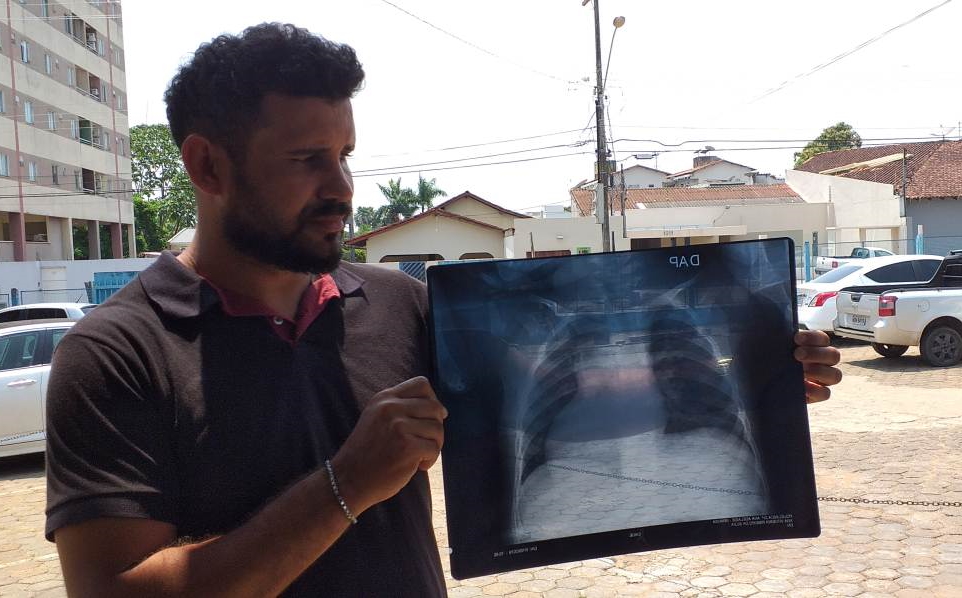
Mauro Ribeiro do Nascimento holds up an X-ray of his daughter’s lungs, who is suffering after inhaling smoke from Brazil’s fires.
By Fabio Teixeira
Thomson Reuters Foundation
When Maria Augusta Almeida heard her grandson cough incessantly, she knew what was to blame: the fires raging in the Amazon forest, some of them more than 200 miles away from Porto Velho.
The smoke permeating the city, the capital of Brazil’s northwestern state of Rondonia, is leading concerned parents to wait for hours in line at local hospitals to get help for their children who are struggling to breathe.
The Thomson Reuters Foundation visited four health centers in the city, one of the hardest hit by smoke from the burning rainforest.
In all, there were reports of children, some of them infants, seeking medical care due to smoke inhalation.
Last month, Brazil’s space research agency, INPE, revealed that the number of fires in the Amazon was the highest since 2010.
That sparked international calls for the country to do more to protect the world’s largest tropical rainforest – key to curbing climate change – from deforestation and other threats.
After several days of public protests and criticism from world leaders, Brazilian President Jair Bolsonaro authorized the military to fight the fires.
In Porto Velho, residents said the Cosme e Damiao Children’s Hospital, run by the Rondonia state government, had become the epicenter for children with breathing difficulties.
The symptoms from outdoor smoke inhalation have evolved into a full-blown crisis for some parents, as they do not know how to protect their children from what is in the air.
The daughter of local salesman Mauro Ribeiro do Nascimento, almost 2 years old, has asthma and could not stop coughing.
“I have taken her to Cosme e Damiao three times already,” her father said.
“They were doing nothing but putting her on a nebulizer.”
The device helps patients with respiratory problems breathe in medicine as a mist through a mask or a mouthpiece.
Worried about the strain on her lungs, do Nascimento took his daughter to a different center for an X-ray, which showed her lungs were “congested” due to irritation caused by smoke.
Staff at Cosme e Damiao were not authorized to say how many children they had attended since the fires escalated and did not respond to requests for comment.
But volunteers and locals said the lines grew much longer about a month ago, when smoke began choking the city streets.
“The city was so filled with smoke you did not know if you should keep the windows open to maybe get some fresh air, or close them to stop more smoke from getting in,” said Sara Albino, a nursing student who volunteers at the hospital.
At her worst, Albino’s 20-month-old daughter had to use a nebulizer five times a day.
Eye drops had to be applied constantly to ease the burning sensation in the child’s eyes.
“Her eyes would not stop tearing up…they were almost glued shut; it was like conjunctivitis,” Albino said.
Urban fires
According to the World Health Organization, fires in the Amazon pose a risk to health including from respiratory diseases, especially in children.
Not all fires affecting Porto Velho are far away in the jungle, as they have become a cheap way to clear vegetation from urban areas for construction purposes, according to residents.
Recently the city’s airport had to shut down after smoke from an urban fire got out of control.
The vegetation on the roadsides leading to the airport was burned to a crisp.
The fires in Brazil’s sprawling Amazon rainforest have receded slightly since Bolsonaro sent in the military to help battle the blazes. last week.
Meanwhile, families do what they can at home.
“I bought a humidifier…we keep it in my granddaughter’s room,” said 71-year-old Raimundo dos Santos, who was selling water to people waiting in line at a Porto Velho health center.
The machine, which increases moisture in the air, has helped his 8-year-old granddaughter breathe.
But the rest of the family is still struggling.
“I myself have already been to the hospital since the fires started,” dos Santos said, adding that he was treated for smoke inhalation.
+++++
Thomson Reuters Foundation, the charitable arm of Thomson Reuters, covers humanitarian news, climate change, women’s and LGBT+ rights, human trafficking and property rights.
